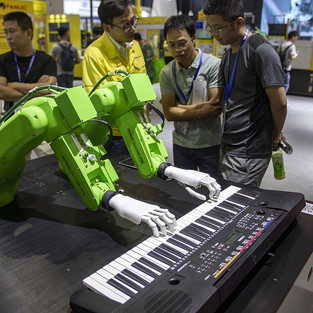
Embracing automation is critical to the long-term success of the pharmaceutical industry. While robotics has long been used in the automobile industry and other manufacturing sectors, robotics has only recently been ready for pharmaceutical plants.
One of the most significant concerns about introducing or expanding robotics in pharmaceutical facilities is worker safety. However, recent advances in technology have led to a new type of manufacturing robot, the cobot, that is ready to safely share a workspace with human coworkers.
Understanding Different Types of Manufacturing Robots
The common image of manufacturing robots continues to be that of a huge metal arm with a claw that lifts massive sheets of metal in a plant. However, this only one type of manufacturing robot.
When it comes to designing a safe workspace that is also optimized for robotic automation, you need to understand that there are three different types of manufacturing robots.
Some robots need to be separated from human coworkers. These are large, industrial-scale robots that perform their functions independently of humans. They need designated workspaces where workers can remotely shut down robots before entering the space. These robots also come equipped with sensors that will shut them down when a human enters their area.
A second type of manufacturing robot can operate within the same area as humans. However, the robots still need a designated work area that people are not allowed to enter while the machine is in operation. These machines have more advanced sensors and will slow down when humans are within a certain range and stop completely if a human enters their defined workspace.
The third type of manufacturing robots cooperate with humans to perform complex or repetitive tasks. These robots have been specially designed to safely share a workspace with humans, without needing a separate zone or room. They often interact directly with human workers.
Designated Workspace

Once you understand what type of robot you want to install in your facility, you need to design the floor to safely accommodate your human employees and the robots. The most important safety feature is establishing designated workspaces for all of your robotics that cannot work alongside humans.
The type of space will be different for each machine. For example, palletizing robotics need large areas where they are caged in to prevent humans from being injured while the robot is in operation.
Many packaging robots do not need a separate room or cage but do require you to mark off an area of the floor with caution markings to keep people a safe distance away from the machine while it is in operation.
Creating the designated areas for your robotics is only part of the safety process. You also need to train your employees about the importance of avoiding the designated robotics work areas, how to perform an emergency shutoff, and how to report any safety concerns.
Robots and Sharing Workspaces
When you install robots that do not require a designated work area, you face a different set of safety issues. One significant issue is your employees’ comfort level with working alongside machines.
You will want to educate your employees about the role each robot performs, and the safety features each machine has. These collaborative robots typically have rounded corners and proximity sensors. These robots often perform precise, repetitive tasks that do not require excessive amounts of force.
Bumping into one of these specially designed robots will be similar to bumping into a human coworker.
Some robots are hand-guided; they only operate when a human is controlling them. Employees need to learn how to operate these machines in a way that is safe for them and their coworkers.
If you want to remain competitive in the years ahead, your facilities will need to become safer and more efficient. Robotics is the most cost-effective way to increase facility productivity while still providing a safe work environment for everyone.














Yorumlar